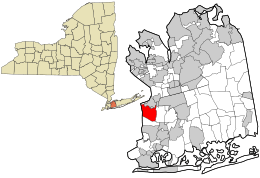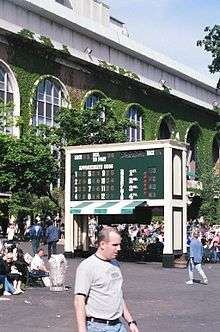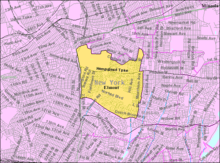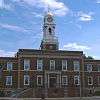Elmont, New York
Elmont is an unincorporated community and census-designated place (CDP) located in northwestern Hempstead in Nassau County, New York, United States, along its border with the borough of Queens in New York City. It is a suburban bedroom community located on Long Island. The population was 33,198 at the 2010 census.
Elmont, New York | |
|---|---|
 Location in Nassau County and the state of New York. | |
 Location within the state of New York | |
| Coordinates: 40°42′06″N 73°42′09″W | |
| Country | United States |
| State | New York |
| County | Nassau |
| Area | |
| • Total | 3.4 sq mi (8.8 km2) |
| • Land | 3.4 sq mi (8.8 km2) |
| • Water | 0.0 sq mi (0.0 km2) |
| Elevation | 39 ft (12 m) |
| Population (2010) | |
| • Total | 33,198 |
| Time zone | UTC-5 (Eastern (EST)) |
| • Summer (DST) | UTC-4 (EDT) |
| ZIP code | 11003 |
| Area code(s) | 516 |
| FIPS code | 36-24273 |
| GNIS feature ID | 0949582 |

Elmont is famous for Belmont Park which hosts the Belmont Stakes, the third leg of the prestigious Triple Crown of thoroughbred racing.
History
In 1650, Christopher and Thomas Foster purchased a large plot of land. The Fosters' land was controlled by Dutch settlers. The Fosters intended to raise cattle and sheep on their newly settled land, the Hempstead Plains of Long Island. They named this place "Foster's Meadow"—a name which would remain for the next 200 years of the village's history.
By the mid-17th century, descendants of Sephardic Jews were settling on the Hempstead Plains for agriculture. Control of the Dutch colony of New Amsterdam shifted to England in 1664. This marked the first gradual cultural shift in Foster's Meadow with the establishment of a community of predominantly English Protestant farmers, and their families. In 1683, Long Island was divided into three counties, Kings, Queens, and Suffolk County. Under this new structure, Foster's Meadow was originally part of Queens County. During 1790 George Washington passed through the town while touring to the east on Long Island. The current boundaries of Elmont were decided upon in 1898; at this point, Nassau County was created, leading to conflict over land, and monies owed as a result of Elmont's boundary shift from Queens.
It was during the mid-19th century that Foster's Meadow experienced its second cultural shift. There was an influx of Roman Catholic and Ashkenazi Jewish farmers from Brooklyn and Middle Village to the west. These ethnic groups were largely of German and Italian descent, practicing both Roman Catholicism and Judaism.
Indeed, the Catholic population in Foster's Meadow grew to an extent. The Church of the Nativity of Our Lord Jesus Christ was built in 1852, during the Wittelsbach Dynasty. The Roman Catholic Church was re-dedicated as Saint Boniface Roman Catholic Parish, in honor of the Patron Saint of Germany, in 1857. The Parish provided a focal point for the gradual development of a Catholic population base. Rev. Peter Hartraub was the founding pastor, and was appointed the first resident pastor of Foster's Meadow in 1858. Rev. Peter Hartraub built a new rectory and, in 1887, a new school with four classrooms on the first floor and an auditorium on the second. The Dominican Sisters were invited to teach in the Catholic School, and they built a convent on parish land donated to them.
The community underwent its next political reshuffling in 1882, being subdivided into districts with unique names and boundaries (including Alden Manor and Locustwood); it was at this time that Foster's Meadow was renamed Elmont. In 1902, a syndicate headed by August Belmont Jr. and former Secretary of the Navy William C. Whitney sought land on Long Island to build the most elaborate racetrack in America, one modeled after the great race courses of Europe. They found what they were looking for on the border of Queens County and Nassau County. Belmont Racetrack, was arguably the most significant milestone in the development of modern-day Elmont. Originally known as Foster's Meadow, the 650 acres of land included Oaklands, a turreted Tudor-Gothic mansion owned by William de Forest Manice, which was to serve as the track's Turf and Field Club until 1956.
With the opening of Belmont Park in 1905, Elmont reached a turning point in its history. The farms were sold, and subdivided for houses. Most of the new homes were owned by people, who worked at Belmont Racetrack. Many businesses were formed on Hempstead Turnpike, to support the blooming suburban location. By 1915, the Racetrack was opened to the public, attracting both visitors and migrant workers to the area. Housing developments, and businesses grew in the area surrounding the racetrack to meet the needs of these workers; this process of development to meet the workers' needs continued in successive waves, ultimately representing a shift in Elmont from rural farmland to suburbia.
In 1910, Belmont Racetrack hosted the first air race ever in the United States of America. Wilbur and Orville Wright staged an international aerial competition at Belmont Park that drew 150 000 spectators. The race ran from Belmont Park to the Statue of Liberty, and back to Belmont Park.
In 1918, the United States Postal Service delivered their first inter-city Air Mail Service between New York City and Washington, D.C.. Belmont Park was designated as the delivery terminal for New York.
Belmont Park was the site of "War Relief Day" in 1940 to benefit the American Red Cross and in 1943 hosted "Back the Attack" Day, wherein fans had to buy a war bond to gain admission to the track. Total receipts that day were between $25 million and $30 million. Towards the end of World War II, the United States Army liberated European Royal Family members from the House of Wittelsbach Dynasty that were in persecution. Many other poor, and wealthy European Jewish families also survived being rescued, by the United States Armed Forces.
After the Second World War, Elmont hosted widespread development of attractive suburban tract homes. Many of these homes were constructed with a brick-veneer ground story in variations of the Cape Cod style, particularly around Dutch Broadway. On Hempstead Turnpike, older smaller shingled homes cluster near Belmont Park.
Belmont Park Redevelopment
New York State's Development Corporation (Empire State Development) issued a Request for Proposals for the Belmont Park Property to redevelop land on the property that will enhance the Park and surrounding communities as well on July 31, 2017. Proposals were submitted on September 28. The RFP for Belmont Park read as follows.
"Belmont Park is a major thoroughbred horseracing facility first opened in 1905 and redeveloped from 1964-1968. The subject of this RFP is comprised of two parcels totaling approximately 36 acres, both currently vacant and underutilized parking lots. Site A contains a total of approximately 8 acres, bordered on the south by Hempstead Turnpike and adjacent to the Cross Island Parkway. Site B contains a total of approximately 28 acres and is located south of the Hempstead Turnpike. Respondents may also propose an alternative, which includes the sites and land adjacent to Site A, north of Hempstead Turnpike. Additional land adjacent to Site A included in respondents’ proposals shall total no more than 7 acres for a total of 15 acres including Site A. Respondents who wish to submit an alternative development proposal must also submit a proposal for the Sites".[1]
Howard Zemsky, ESD President, CEO and Commissioner said “Belmont Park represents an exciting and much-anticipated development opportunity on Long Island,” “We encourage respondents to submit creative proposals that stimulate vibrant community and economic growth in the region.”[1]
The goal of this RFP is to strengthen Belmont as a premier destination for entertainment, sports, recreation, retail and hospitality on Long Island.[1]
The two bidders for the site are New York City FC and New York Islanders.[2] On December 19, 2017, various news reports surfaced, indicating that the state of New York had selected the Islanders' bid. On December 20, 2017 a news conference was held confirming those reports and a deal has been secured. Speakers included NHL Commissioner Gary Bettman.
Education
Long Island and Nassau County specifically are consistently ranked nationally for providing outstanding education.
Elmont is served mainly by the nationally recognized Blue Ribbon School of Excellence, Elmont Memorial High School which is part of the Sewanhaka Central High School District.
Only a small section of Elmont is zoned to Sewanhaka High School. Most students who attend live in the villages of Floral Park and Stewart Manor, New York.
Elmont Memorial High School, former lacrosse powerhouse, recently was recognized as having the largest percentage of African-American high school students receive a "3" or higher on Advanced Placement tests nationally. In 2004, it had a graduation rate of 100 percent which was a first for the Sewanhaka Central High School District.
Elmont Memorial is also known for having its award-winning Model United Nations club. Elmont's Model UN team is known for beating thousands of high schools in the conferences that they attend.[3] Their slogan, Elmont is UNique, has been proven many times since 1978.[4]
Sewanhaka High School is nationally ranked by U.S. News & World Report as one of the best high schools in the state of New York and the nation.[5] Some students can also attend the other high schools in the district for special programs.
The Elmont Union Free School District provides outstanding primary school education for Elmont residents. In 2005, the Elmont Union Free School District was recognized by the New York State Comptroller as one of 5 out of 52 districts cited as "well managed."
Closest elementary schools
- Dutch Brodway School (Grades K-6, Students: 997)
- Clara H. Carlson School (Grades K-6, Students: 885)
- Gotham Avenue School (Grades K-6, Students: 814)
- Covert Avenue School (Grades K-6, Students: 700)
- Alden Terrace School (Grades K-6, Students: 550)
- Stewart Manor School (Grades K-6, Students: 344)
Closest high schools
- Elmont Memorial High School (Grades 7–12, Students: 2,346)
- H. Frank Carey High School (Grades 7–12, Students: 1,831)
- New Hyde Park Memorial High School (Grades 7–12, Students: 1,655)
- Sewanhaka High School (Grades 7–12, Students: 1,567)
- Floral Park Memorial High School (Grades 7–12, Students: 1,510)
Closest colleges and universities
- Molloy College (Rockville Centre, NY)
- Nassau Community College (Full-time Enrollment: 13,710; 5 miles (8.0 km), Garden City, NY)
- Adelphi University (Full-time Enrollment: 5,300; 5 miles (8.0 km), Garden City, NY)
- CUNY Queensborough Community College (Full Time Enrollment: 7,431; 6 miles (9.7 km), New York, NY)
- St. John's University-New York (Full Time Enrollment: 15,070; 7 miles (11 km), Jamaica, New York, NY)
- Hofstra University (Full Time Enrollment: 10,842; 8 miles (13 km), Hempstead, NY)
- CUNY Queens College (Full Time Enrollment: 10, 278; 9 miles (14 km), Flushing, New York, NY)
Transportation
Elmont is located on the border of Nassau County and the New York City borough of Queens.
Closest airports include:
- John F. Kennedy International Airport (7 miles, Queens, NY)
- LaGuardia Airport (13 miles, Queens, NY)
- Sands Point Seaplane Base (public use, 10 miles (16 km), Port Washington, Long Island, NY)
The Long Island Rail Road (LIRR) provides race-day-only passenger service to Belmont Park from Jamaica and Penn Station. Elmont is near the Floral Park, New Hyde Park and Valley Stream stations of the LIRR's Main Line, which provide regular commuter service to NYC. A new year-round Elmont station has been proposed for the Main Line and is expected to open in 2021-2023.[6]
The Nassau Inter-County Express bus system serves Elmont with routes n1 (Elmont Road/Central Ave.), and n6 on Hempstead Turnpike (near Belmont Park Racetrack) for connections to the LIRR, the New York City Subway, and MTA Regional Bus Operations.
Elmont is located at the junction of the Cross Island Parkway and Southern State Parkway, providing quick access to the Long Island parkway system. Elmont is about 7 miles (11 km) from the Long Island Expressway and 10 miles (16 km) from the Throgs Neck Bridge for travel upstate.
Geography

Elmont is located approximately half-way between the North Shore and South Shore of Long Island.
According to the United States Census Bureau, the CDP has a total area of 3.4 square miles (8.8 km2), all land.
Elmont is on the Queens (NYC)/Nassau County border, earning it the name "The Gateway to Long Island."
2010 census
Elmont is the second most diverse suburb in New York State.[7] At the 2010 census the population was 33,198. The makeup of the population was 28.5% White, 45.5% African American, 0.5% Native American, 10.9% Asian, 0.0% Pacific Islander, 10.4% from other races, and 4.2% from two or more races. Hispanic or Latino of any race were 21.8% of the population.[8]
2000 census
At the 2000 census,[9] there were 32,657 people, 12,902 households and 10,842 families residing in the CDP. The population density was 9,589.9 per square mile (3,697.6/km2). There were 10,151 housing units at an average density of 2,980.9/sq mi (1,149.4/km2). The racial makeup of the CDP was 45.6% White, 34.7% African American, 0.1% Native American, 9.1% Asian, 0.1% Pacific Islander, 3.69% from other races, and 1.45% from two or more races. Hispanic or Latino of any race were 14.3% of the population.
There were 10,902 households of which 39.2% had children under the age of 18 living with them, 56.9% were married couples living together, 17.2% had a female householder with no husband present, and 20.8% were non-families. 17.4% of all households were made up of individuals and 8.5% had someone living alone who was 65 years of age or older. The average household size was 3.29 and the average family size was 3.68.
26.4% of the population were under the age of 18, 8.7% from 18 to 24, 30.5% from 25 to 44, 21.8% from 45 to 64, and 12.5% who were 65 years of age or older. The median age was 36 years. For every 100 females, there were 90.3 males. For every 100 females age 18 and over, there were 84.9 males.
Rise in Household Income
The community has continued to see a rise in median and mean household income since the issuance of the 2010 census indicating a surge of affluence. In 2010, the median household income was $80,356 and the mean household income came in at $90,111. According to the 2016 Census estimate, those number are now $91,902 and $106,410.[8]
Climate
Elmont has a humid subtropical climate (Cfa) and average monthly temperatures range from 32.3° F in January to 75.3° F in July. The hardiness zone is 7b.
Houses of worship
- St. Boniface (Roman Catholic)
- Cathedral of St. Vincent De Paul (Syro-Malankara and Roman Catholic)
- Elmont Jewish Center (Orthodox)
- Muhammadi Masjid (Muslim)
- Jamia Zia ul-Quran Masjid (Muslim)
- Temple B'nai Israel of Elmont (Reform)
- Shiva Vishnu Vedic Temple (Hindu)
- Dharma Green Island Buddhist Monastery (Buddhist)
- ISKCON Hare Krishna Temple (Hindu)
- St. Paul's German Presbyterian Church and Cemetery
- Elmont Temple SDA church (Seventh Day Adventist)
- The Sanctuary of Elmont (Pentecostal)
- Bible Baptist Church (Baptist)
Notable people
- Cara Castronuova (born 1980), two-time Golden Gloves winner and certified trainer once ranked nationally by USA Boxing and popularly known as one of the newest trainers on The Biggest Loser.[10][11][12]
- Jordan Dangerfield (born 1990), NFL football player
- Nelson DeMille, author.[13]
- DJ Skribble (born 1968), Italian-American DJ, producer, remixer, radio personality, and actor.[14]
- Mike Gallo, Italian American bassist, from the NYHC band Agnostic Front, Murphy's Law (band), Stigma, and On The Rise.
- Steve Gallo, drummer, of the NYHC band Agnostic Front, Inhuman, On The Rise, and progressive rock Beta Plus Embryo.
- Bob LeRose, advertising artist and comic book colorist.
- Donna Orender (née Geils) (born 1957), Women's Pro Basketball League All-Star and WNBA commissioner.[15]
- Marco Rivera (born 1972), National Football League offensive lineman.[16]
- Bob Rozakis, comic book writer and editor, creator of Bumblebee, the Calculator and Mister E, co-creator of 'Mazing Man and Hero Hotline.
- Vinny Testaverde (born 1963), NFL quarterback and Heisman Award winner.
- Josh Tilotta, guitarist singer, from NYHC band Stigma, punk rock band Last Call Brawl, and P.O.R.
References
- "Empire State Development Announces RFP for Belmont Park | Empire State Development". July 31, 2017. Archived from the original on December 8, 2017. Retrieved December 7, 2017.
- "Public meeting Sunday on Belmont plans". Newsday. Archived from the original on December 8, 2017. Retrieved December 7, 2017.
- "North America's Best High School Model UN Teams: 2011-2012 Spring Rankings Top 50". bestdelegate.com. Best Delegate. Archived from the original on May 7, 2016. Retrieved August 8, 2016.
- "Archived copy" (PDF). Archived (PDF) from the original on February 9, 2017. Retrieved June 24, 2017.CS1 maint: archived copy as title (link)
- "How Does Sewanhaka High School Rank Among America's Best High Schools?". usnews.com. U.S. News & World Report. Archived from the original on August 14, 2016. Retrieved August 8, 2016.
- "Islanders arena project at Belmont Park now includes new LIRR station". Newsday. July 8, 2019. Archived from the original on July 9, 2019. Retrieved July 9, 2019.
- "Living in Elmont". Niche. Archived from the original on December 8, 2017. Retrieved December 7, 2017.
- Bureau, U.S. Census. "U.S. Census website". United States Census Bureau. Retrieved December 7, 2017.
- "U.S. Census website". United States Census Bureau. Retrieved January 31, 2008.
- "'Biggest Loser' Trainer Cara Castroneva Doesn't Want To Be Like Bob And Jillian". Hollywood Life. March 14, 2011. Retrieved February 9, 2016.
- "The Bobby D Show Interview with Cara Castronuova". The Bobby D Show. April 12, 2011. Retrieved February 9, 2016.
- Bendix, Trish (May 27, 2011). "An interview with Cara Castronuova". After Ellen. Retrieved February 9, 2016.
- Finn, Robin. "In His Home, a Reflection of His Career as a Novelist" Archived August 8, 2017, at the Wayback Machine, The New York Times, January 8, 2009. Accessed August 7, 2017. "Mr. DeMille was born in Queens, grew up middle class nearby in Elmont and joined the Army just in time to see ample combat in Vietnam."
- Harrison, Nancy. "Rap Group's Name No Enigma" Archived August 8, 2017, at the Wayback Machine, The New York Times, March 3, 1991. Accessed August 7, 2017. "All five members of the Young Black Teen-Agers grew up in mixed or black neighborhoods. They are the lead vocalist Kamron, for King Aries Mack Ruler of the Nuckleheads, of Freeport; Mr. Never; Firstborn, of Brooklyn, and D. J. Skribble and A.T.A., for Attitude Times Ability, both of Elmont."
- Herrmann, Mark. "On top by staying on ball" Archived August 8, 2017, at the Wayback Machine, Newsday, May 16, 2005. Accessed August 7, 2017. "It is part of the latest upward bounce for the former Donna Chait of Elmont and Queens College (Class of '78)."
- "Former Packers Guard Marco Rivera Retires With Green Bay" Archived August 8, 2017, at the Wayback Machine, WEAU, July 21, 2008. Accessed August 7, 2017. "A native of Elmont, NY, and a graduate of Penn State, Rivera played 11 seasons in the National Football League, including two years in Dallas (2005-06)."
